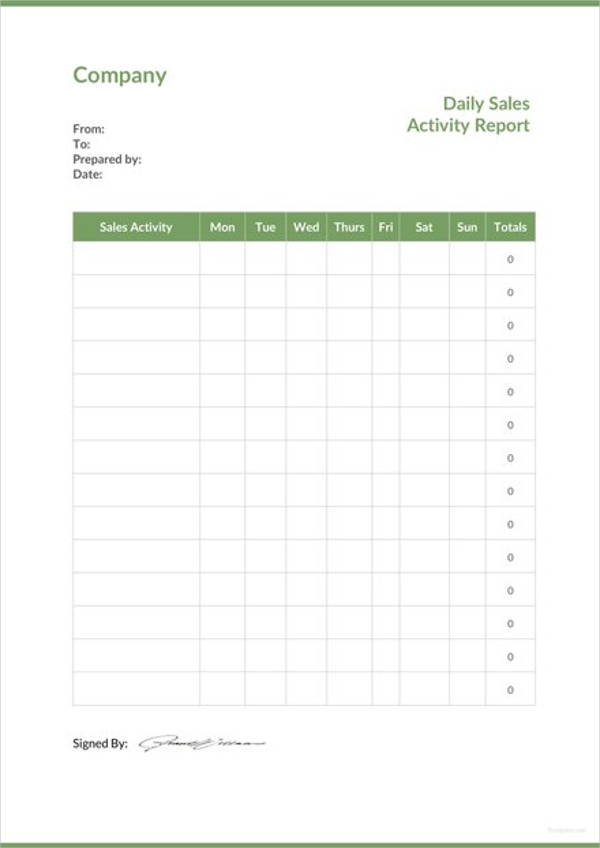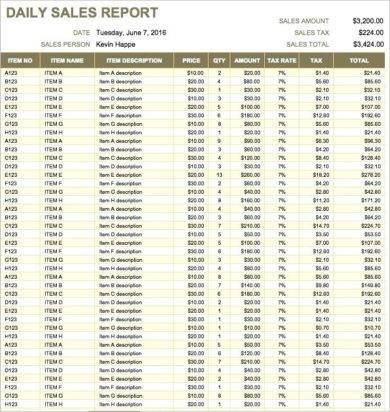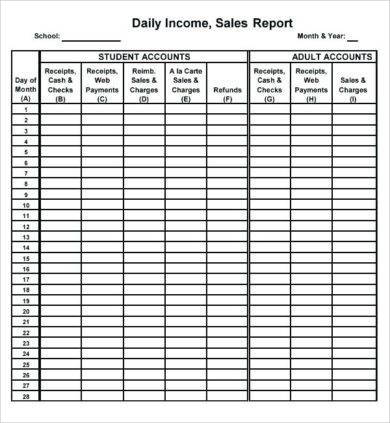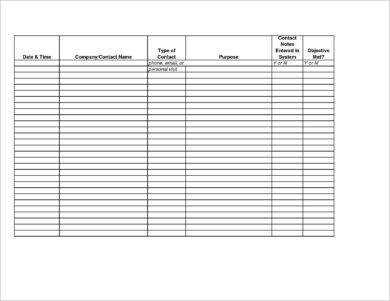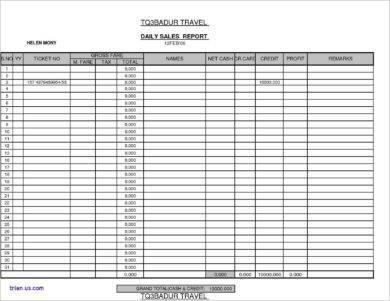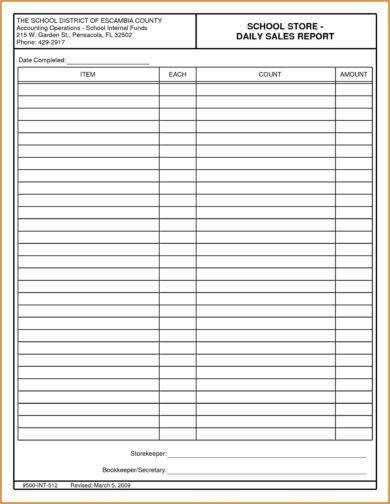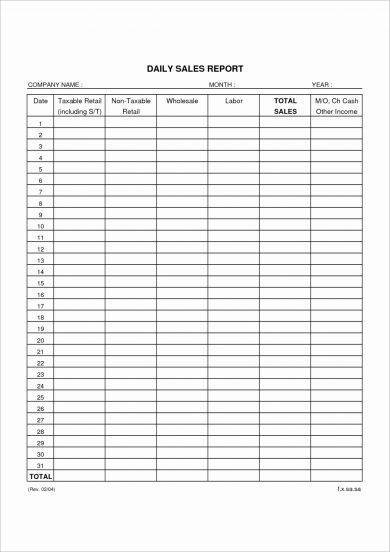13+ Daily Sales Report Examples to Download
Running an organization is a lot more complicated than just sitting behind a desk, typing on your computer, and answering phone calls and emails within the day.
As a sales manager, you want to stay on top of things to ensure that your company grows along with its market. But sometimes, it can be hard to identify who or what is contributing to its success (or lack thereof). After all, there are many steps and procedures that are involved in the sales process—and this is where general sales reporting comes in.
Though there are many ways to perform a sound financial tracking system, a daily sales report serves as the core tracking element for controlling an organization’s cash, measuring its cost and sales performance, and forecasting future sales along the way. You may also see monthly report examples.
But to understand how a daily sales report is created, we must first look into what sales reporting really is and the role it plays in keeping a sales team on track. In this article, we will discuss all you need to know about sales reports and a few tips on how to create one.
Daily Sales Report Design Example
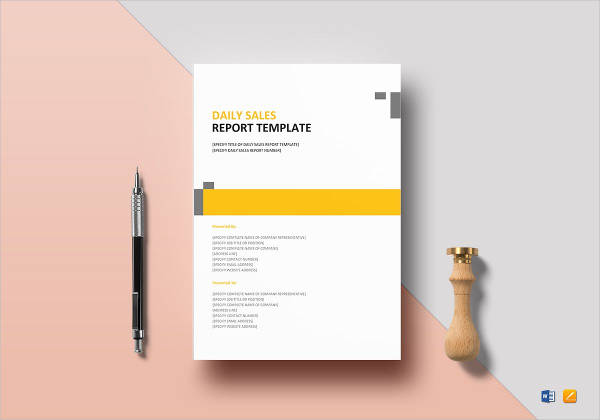
Restaurant Daily Sales Report Design Example
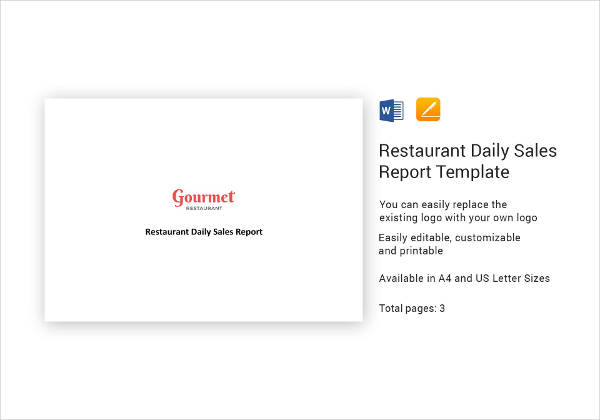
Daily Sales Activity Report Example
Daily Sales Report Example
An Introduction to Sales Reports
The sales cycle can be a long, grueling process to begin with. While some prospects are easy to convert, others can take a lot longer than most. Some clients or customers simply require a different kind of selling approach to close a deal. At the other end of the spectrum, you might even have a few sales representatives with an otherwise different style of functioning. You may also see marketing report examples.
Every step of the sales cycle is crucial to the company’s success, which is why keeping track of significant information is vital to help improve your results.
Part of being a sales manager is having the knowledge of the process of the sale. This includes the touches or activities necessary to close a deal, along with how long a deal can stay in the sales pipeline, where it’s likely to get held up, and so much more. You may also like recruitment report examples.
Good sales reporting provides managers with enough insight on the process and foundation of a successful sales operation. This can help predict where an organization’s success lies and what can be done to improve its results. But it takes more than just the numbers to measure a company’s growth, as sales managers must also look into who or what is driving those sales to maximize on such as your market continues to grow. You may also check out financial report examples.
Once you have fully understood the reasons behind your data and its corresponding results, it would be easier to focus your team’s efforts in managing decisions regarding production quantities, employment needs, pricing, timelines, and other necessary components that keep your business flourishing. You might be interested in annual report examples.
Although there are many things to report on, for most sales managers, it all boils down to what’s essential to the company’s growth and measuring every factor to make the best possible decisions for the business.
Here are a few fundamental data points you may want to emphasize on your sales report:
1. Number of prospects
Round up the total number of deals you have in all stages of your sales pipeline. This includes prospects who are interested in your services, those who have been inquiring and meeting up with your sales team, and leads who are close to sealing a deal. It’s important to note where they are, when they are expected to close a deal, and the likelihood of bringing revenue for your business. You may also see weekly sales activity report examples.
2. Deal size
Sales contracts can vary greatly depending on a number of factors related to the product or service available and the offer provided by a prospect or sales rep. Even so, you still need to identify the average size of the deal in your sales pipeline in order to make a quick but credible sales forecast and strategy. You may also like technical report examples.
3. Conversion rate
This should verify the average number of open deals necessary to close one deal. This is usually determined through past results.
4. Sales cycle time
The sales velocity determines the average time it takes for a prospect to complete the sales cycle. The faster it takes for a deal to close, the better for your team.
Comprehensive Daily Sales Report Template
Daily Income Sales Report Example
Daily Sales Activity Report Example
Daily Sales Call Report Example
Daily Sales Report Template
The Importance of Sales Reporting
Managing a sales force without an effective reporting system is almost like driving with your eyes closed with no direction of where you’re headed. Now imagine if your team failed to submit a daily or weekly sales report to update you on the latest happenings, how can you expect operations to run as smoothly when you’re completely unaware of the wrongful decisions and mistakes made by your team? You may also see business report examples.
There are three essential reports that any well-run sales organization should have. These are as follows:
1. The Daily Call Report
A daily call report provides information about the number of times a sales rep has called customers, who they spoke to, what they talked about, and an action plan for these scheduled calls. These reports are usually turned in on a day-to-day basis and must be reviewed every other day for a timely evaluation.
2. The Productivity Report
Think of the amount of resources wasted if a sales manager failed to monitor a sales team’s productivity. A productivity report should show the activity level taking place within the sales organization and ensure that each salesperson is meeting (or even exceeding) the specified productivity standards. You may also like trip report examples.
The data included in the productivity report typically covers the number of outbound calls, conversations, voice mails, client meetings, and sales presentations.
Productivity reports must be submitted and reviewed on a weekly basis. The phone bill and the daily call report are both used to verify the information stated in the given simple report.
3. The Sales Forecast
A sales forecast can assist managers in estimating revenue, determining sales opportunities that require attention, and paving the way for any post-sale product or service deliveries. This document generally contains data regarding client names, sales opportunity sizes, sales cycle indications, and the specific items customers are buying. You may also check out sample activity reports.
However, sales representatives must clearly understand the exact criteria that a prospective account should meet before they may be allowed to include it in the forecast. Otherwise, the data would be useless.
Printable Daily Sales Report Example
School Daily Sales Report Example
Simple Daily Sales Report Example
Company Daily Sales Report Example
Blank Daily Sales Report Example
Guidelines to Creating a Sales Report
Have you ever sat through a meeting where the sales manager presented an overly complex sales report that gave no clear indications of how the sales team is performing?
Given how the sales team is arguably the engine of a for-profit organization, the data found in the sales report can greatly impact the decisions made by company executives. You may also see consulting report examples.
This includes decisions on whether the company should hire a few more sales reps, if certain products need to be discontinued, if pay bonuses were considerable, and the list goes on. This plays a critical role in helping a manager oversee the success of a sales team and the entire company. You may also like incident report examples.
Hence, it’s important to create a report that clearly and concisely showcases the most significant information that business executives need to prevent potholes in your road toward growth and success.
That being said, follow these seven steps to creating a well-defined sales report your bosses will surely like:
1. Keep your audience in mind.
Being a sales manager can often be overwhelming. Though the amount of information you receive may be relevant to you and your line of work, will it be necessary for or useful to your company’s management team? The best way to prevent a lengthy and meaningless report is to start considering your audience and their needs. You may also check out employee report examples.
Keep in mind that your bosses may have varying interests in regards to the content of your report. Your vice president may want to know how your sales reps have been converting leads through different marketing strategies, while your chief financial officer may want all the information about your major sales numbers and expenses.
These differences will help you determine the type of data to emphasize in your report. You need to make sure the sales report reflects the needs of its intended audience for effective delivery.
2. Share the right information.
Once you have identified the primary audience of your report, decide what information will give them an accurate look of how your team is performing. Whatever is written on the report should help them make strategic decisions to keep the department and the entire company on track. You may also see formal business report examples.
Reports that are submitted to an organization’s upper management usually respond to the following questions:
- Are your sales goals being met?
- How is your sales team’s performance compared to previous periods?
- Which product or service offers are selling the most?
- Which product or service offers failed to meet their desired expectations?
- What is your sales forecast for the next month, quarter, or year?
- What are the key opportunities and challenges faced by your organization?
It isn’t necessary to provide all this information for every report you create, as you still need to take the first step in this process into account. Unless your boss tells you not to, there’s no harm in constructing a more comprehensive report of your sales performance. You may also like weekly activity report examples.
3. Decide on a time period.
Hefty reports can take forever to go through, which is why it’s always best to focus on particular time periods instead. Some companies produce daily, weekly, or monthly reports to serve as a reference for their year-end reviews. Since sales reporting can be a time-consuming task to execute, you need to decide on a time period that best suits the nature and size of your business.
4. Select the proper visuals.
The manner in which you convey your message is just as important as the message itself. A good sales report should carry information that is understandable, digestible, and actionable to its intended readers.
In most cases, managers use visual illustrations in the form of bar graphs, pie charts, and line graphs to showcase data in a way that is comprehensible at first glance. Visually crafting your data is more than just making your report look pretty, but it’s also about delivering engaging information that is easy to understand.
5. Gather essential data.
It’s impossible to build a solid sales report without the right information. This is why many companies use a CRM (Customer Relationship Management) system to capture, track, and filter out data to make it easier for managers to analyze this information before it is reflected in the professional report.
Ensure that the CRM system is capable of handling information that allows quick and easy data management for you to create a highly focused and compelling sales report in the nick of time.
6. Focus on the specifics.
As if this hasn’t been emphasized enough, focus on putting together a clear and concise sales report. It might be tempting to present as much data as possible, but the last thing you’d want to do is drown your bosses with piles of information that aren’t completely relevant to your main point. You may also check out expense report examples.
7. Add context when necessary.
Though numbers may give you an idea of what’s happening, they don’t tell you the full story. Data can easily be manipulated or misinterpreted when not presented correctly. So before you hand over your basic report to the management team, make sure to put the numbers into context when necessary. This way, your bosses would know exactly what’s happening within the sales team.
Sales reporting may seem like a big, daunting task to conquer, but the information carried by these standard reports can be beneficial to the company’s growth and success in a lot of ways. If you stay committed to tracking your sales team’s progress, you can gradually increase performance levels and lead the company to a brighter, more promising future in the competitive industry it is in.



